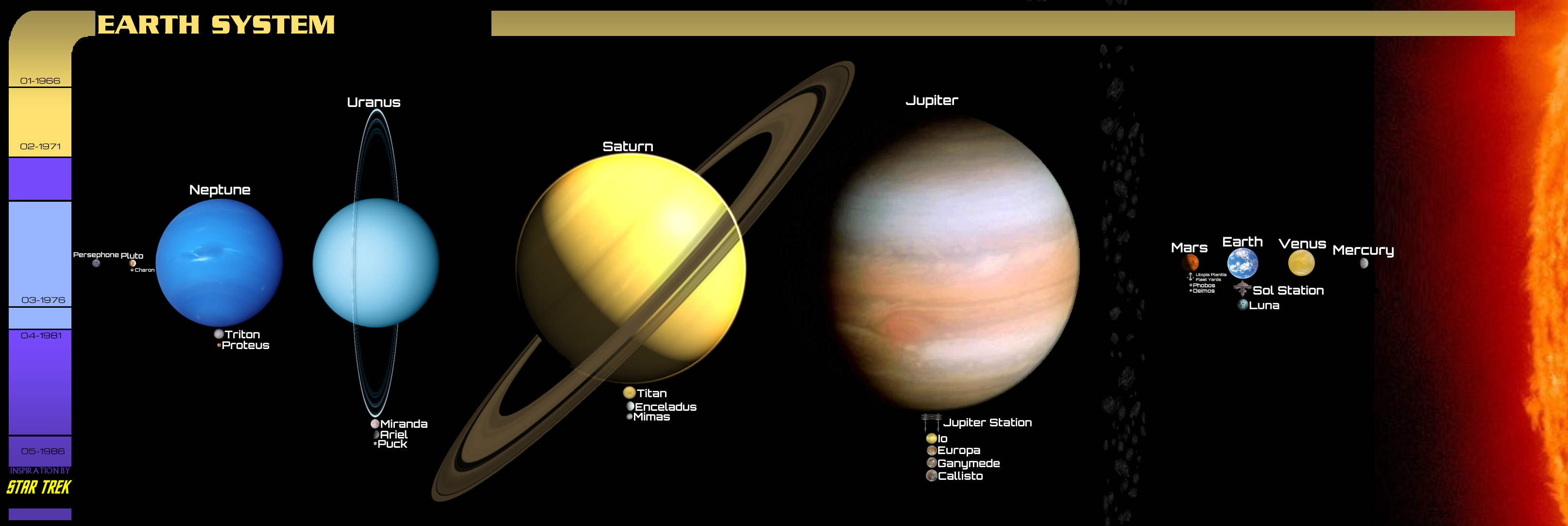HOME | DD
 Reesecandy2003 — Star Trek: Earth System
Reesecandy2003 — Star Trek: Earth System

#fan #fanart #star #starsystem #startrek #trek #star_trek #art #solarsystem #planetary_system
Published: 2023-08-09 02:16:26 +0000 UTC; Views: 5639; Favourites: 57; Downloads: 30
Redirect to original
Description
Inspired by EvanVizuett , Rebus2077 , Matusurvive , SC2HayasuiArts , sheepman5003 , and Me!This is it, the Star Trek TV series, Movie Series, Video Game Series, Comic Book Series, etc.. The Star Trek version of Earth (Sol) System, it is a located in Alpha and Beta Quadrant of Sector 001, the capital of the Starfleet Command, United Federation of Planets, United Earth! The federation which encompasses more than 150 member planets and thousands of colonies spread across 8,000 light-years! But also the expansion of Lightyear, Star Trek, Star Wars, ReesecandyVerse, Taur Force 64, Dogs in Space, Final Space, Pikmin, Galaga, and Rick and Morty Universe! Made remembered based on the 1966 tv series.
Planets and Miscellaneous of The Earth System from Star Trek
Sol: A Yellow Dwarf Star as seen in the series
Mercury (Known as I): A Grey Terrestrial Planet that Quickly Orbits Simultaneously, known to be the Fastest Planet Revolving around the Earth's Sun. Closer to the Earth's Sun.
Venus (Known as Sol II): A Yellow Terrestrial Planet with Acid Rain, Yellow clouds and Volcanic Activity. It it the Hottest planet and named after the roman godess of love. There's a Mining Facility and a Base where the Venusians worked here. These Alien Lifeforms are called the Venusians: A Fish-like Monsters with Green Skin and Amphibian Hands and Feet
Earth (Known as Terra, Tellus, Gaia, Sol III): A Terrestrial Planet which means a was the inhabited third planet of the Sol system. Earth was the homeworld of the Humans, Voth, Cetaceans, Neanderthals, Alien Races, among others, and was the capital planet of the United Federation of Planets and the home of Starfleet Headquarters from 2161 to 3089. In 2150, with the last countries joining, the planet was unified under the United Earth government. It was a founding member of the Coalition of Planets in 2155, and of the United Federation of Planets in 2161. By the 24th century, hundreds of humanoid species lived there, including Bolians, Vulcans, and Ktarians. The President's office, the Federation Council, as well as Starfleet Headquarters and the main campus of Starfleet Academy were all located on Earth. Located at the core of the Federation, Earth's strategic importance by the 24th century was on par with worlds like Andor, Berengaria VII, and Vulcan. Through its history, the planet had been targeted by various powers adversarial to Humanity, including the Xindi, the Klingons, the Borg, and the Dominion.
-Sol Station (Known as Probert Station): A Sol Station-type starbase, but most commonly referred to as Spacedock, was a Federation space station located in Earth orbit and operated by Starfleet in the early 25th century . It resembled its predecessor in design, but featured several additional structures. The station was armed with phasers and photon torpedoes . In 2401 , Admiral Jean-Luc Picard and Captain William T. Riker took the USS Titan-A out of the station on an unauthorized mission to find Doctor Beverly Crusher . The following week, Sol Station was the site of celebrations for Frontier Day , for which the entire Federation fleet had been gathered. Amidst a fireworks display , the soon-to-be decommissioned USS Enterprise-F was launched from the station for its farewell cruise, which was followed by a demonstration of fleet formation mode . Shortly after, the fleet was taken over by the Borg Collective and ordered to target Sol Station and the rest of Earth's planetary defenses . The station managed to hold off the assault for some time, long enough for President Anton Chekov to broadcast a distress call , but ultimately its shields failed and it suffered severe damage. As the station fell, so did Earth's planetary shields , leaving the planet defenseless. Earth was saved when the USS Enterprise-D destroyed the Borg cube controlling Starfleet. One year later , Sol Station had been fully repaired. It saw the launch of the newly rechristened USS Enterprise-G, which was attended by Admirals Jean-Luc Picard and Beverly Crusher.
-Luna: A Grey Moon with which means a known colloquially as "The Moon" and elsewhere as Terra Luna, was an inhabited large natural satellite of Earth in the Sol system. Most who had lived on Luna did not actually call it "Luna", this being a term that mostly those on Earth said. Instead the term "the Moon" was retained, a fact that surprised many outsiders.
Mars (Known as Sol IV): A Red Terrestrial Planet with Unbreathable Atmosphere, Canyons, Valleys, Mountains and Cliffs. Which means it, was the inhabited fourth planet of the Sol system. It was located near to the asteroid belt. Mars was one of humanity's oldest colony worlds and the location of Utopia Planitia Fleet Yards, a massive Starfleet shipbuilding facility. Many of the Federation's most famous starships were built here, including the USS Enterprise-D, the USS Defiant, and USS Voyager. On April 5, 2385, the planet was attacked by rogue synths, who destroyed the Utopia Planitia shipyards and bombarded Mars so heavily that they ignited flammable vapors in its stratosphere. The planet continued to burn well into 2399.
-Utopia Planita Fleet Yards (Known as Utopia Planitia Starfleet Yards or Utopia Planitia Shipyards): A Shipyard type was means a key Starfleet vessel construction and design facility in the 24th century. The facility included several large drafting rooms for starship design and planetary facilities on the surface of Mars, as well as a number of drydocks and space stations in orbit. The shipyards were attacked and destroyed by rogue synths in 2385, igniting the planet's atmosphere in the process.
-Phobos: An Asteroid Moon named "Fear" in Greek.
-Deimos: An Asteroid Moon named "Terror" in Greek.
Jupiter (Known as Sol V): A White, Orange, Brown and Grey Gas Giant with Great Red Spot, Hypersonic Winds, Thunderstorms and 92 Moons. It is the Largest Planet in Earth's Solar System
-Jupiter Station (Known as Jupiter Research Station): A Orbital Station-type was means a Starfleet research station located in orbit of Jupiter.
-IO: A Yellow Moon with over 400 active volcanoes, Io is the most geologically active object in the Solar System.
-Europa: A Icy Moon with Under the Ocean inside, with lifeforms. silicate rock and has a water-ice crust[14] and probably an iron–nickel core. It has a very thin atmosphere, composed primarily of oxygen. Its white-beige surface is striated by light tan cracks and streaks, but craters are relatively few. In addition to Earth-bound telescope observations, Europa has been examined by a succession of space-probe flybys, the first occurring in the early 1970s. In September 2022, the Juno spacecraft flew within about 320km (200 miles) of Europa for a more recent close-up view.
-Ganymede: A Light Brown Icy Moon is composed of approximately equal amounts of silicate rock and water. It is a fully differentiated body with an iron-rich, liquid core, and an internal ocean that may contain more water than all of Earth's oceans combined. Its surface is composed of two main types of terrain. Dark regions, saturated with impact craters and dated to four billion years ago, cover about a third of it. Lighter regions, crosscut by extensive grooves and ridges and only slightly less ancient, cover the remainder. The cause of the light terrain's disrupted geology is not fully known, but was likely the result of tectonic activity due to tidal heating.[8] Ganymede orbits Jupiter in roughly seven days and is in a 1:2:4 orbital resonance with the moons Europa and Io, respectively.
-Callisto: A Brown Icy Moon with Its surface is completely covered with impact craters. It does not show any signatures of subsurface processes such as plate tectonics or volcanism, with no signs that geological activity in general has ever occurred, and is thought to have evolved predominantly under the influence of impacts.
Saturn (Known as Sol VI): A Grey and Yellow Gas Giant with Planetary Ringed System and 83 Moons. It is the Largest Ringed Planet in Earth's Solar System which it was named after the Roman God of Farming and Time. There is a floating city called "Dank Laboratories" as seen in Chicken Little: Ace in Action (2006).
-Titan: A Yellow Largest moon with unbreathable atmosphere. It is contained by Water in which it could be life.
-Enceladus: A Small Moon with Volcanoes Spurting Ice and Water Underneath the surface in which it contains habitable life.
-Mimas: A Smallest Moon, Closer to Saturn.
Uranus (Known as Sol VII): A Light Blue Ice Giant with 27 Moons. It is tipped on its side and has planetary rings.
-Miranda: A Small Moon with an inner core of rock surrounded by a mantle of ice.
-Ariel: A Small Moon
-Puck: A Asteroid Moon, closer to Uranus.
Neptune (Known as Sol VIII): A Blue Ice Giant with Great Dark Spot and 14 Moons. It is one of these distant objects in space as seen on Telescopes in the real world.
-Triton: A Icy Moon with its surface is relatively young, with few obvious impact craters. Intricate cryovolcanic and tectonic terrains suggest a complex geological history. Triton has a surface of mostly frozen nitrogen, a mostly water-ice crust,[14] an icy mantle and a substantial core of rock and metal. The core makes up two-thirds of its total mass. The mean density is 2.061 g/cm3,[6] reflecting a composition of approximately 15–35% water ice.
-Proteus: A Red Asteroid Moon
Pluto (Known as Sol IX): A Dwarf Planet which means a 1930 to 2006, after the named "Pluto" from Walt Disney Cartoons.
-Charon: A Icy Moon closer to Pluto.
Persephone (known as Sol X): A Dwarf Planet beyond Neptune.
Made with Photopea.
Star Trek (c) Paramount Global, CBS, Viacom
Updated: 9/15/2023: Changes and replaced to Sol Station!

























